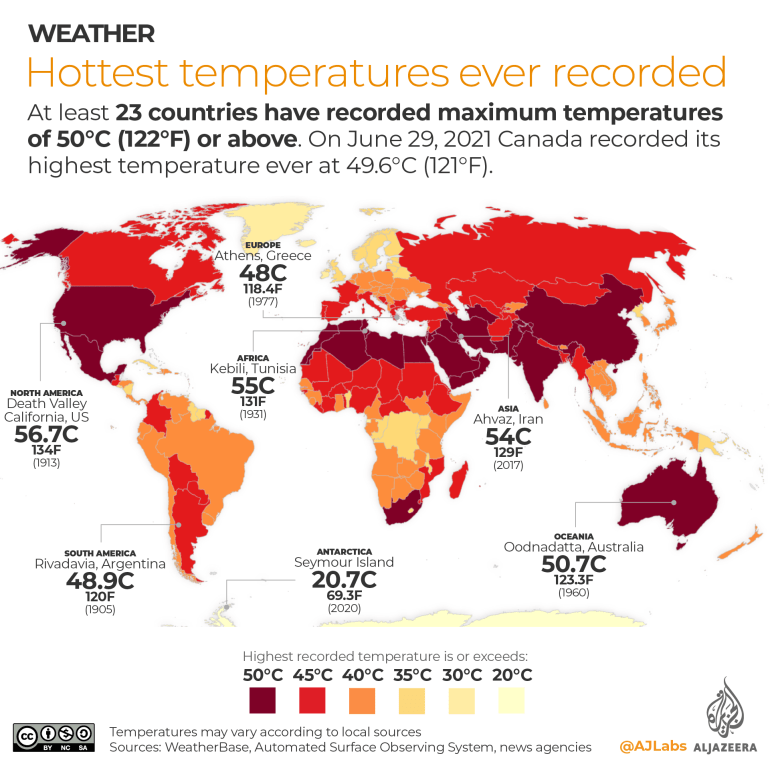North America hit by warmest June on record
Experts warn that heatwaves are occurring more frequently, are more intense, and are lasting longer than before.

North America witnessed its hottest June on record battered by a deadly heatwave searing parts of the region, according to the European Union’s climate monitoring service.
The EU said on Wednesday that its findings illustrate the effects of global warming.
Keep reading
list of 4 itemsEvacuations ordered as wildfires rip through Canada’s west coast
Mapping the hottest temperatures around the world
Global warming bigger threat than coronavirus: Red Cross
Record-breaking heat scorched from the southwest to the northwest of the United States and into Canada, where the all-time record of daily temperature was broken three days in a row in British Columbia.
The region was 1.2 degrees Celsius (2.2 degrees Fahrenheit) above the 1991-2020 average in June, according to the Copernicus Climate Change Service (C3S).
“These heatwaves are not happening in a vacuum. They are happening in a global climate environment that is warming and which makes them more likely to occur,” said C3S climate scientist Julien Nicolas.
Globally, June 2021 joins the same month in 2018 as the fourth warmest June.
C3S produces monthly reports on air temperature, sea ice and the water cycle. It relies on data from satellites, ships, aircraft and weather stations around the globe, as well as model calculations.
📢June #temperature highlights from the #CopernicusClimate Change Service #C3S:
🌡️Globally – joint 4th warmest June on record
🌡️Europe – 2nd warmest June
🌡️Heatwave conditions over western North America, with many temperature records brokenMore detail➡️https://t.co/5cdkQHjo0K pic.twitter.com/XQqhvaoYOH
— Copernicus ECMWF (@CopernicusECMWF) July 7, 2021
Meanwhile, in Europe, June was the second warmest on record for the continent. In the Finnish capital Helsinki, where records go back to 1844, the average June temperature has never been as high as this year.
People in the Russian capital Moscow also struggled with the city’s warmest June day documented so far. It was also warmer than average in Siberia, although not as much as in the previous three years.

Trend to continue
It is already well understood that heatwaves are occurring more frequently, are more intense, and are lasting longer than they did in the past, Nicolas told the AFP news agency.
“The heatwaves that we saw last month in North America, western Russia and northern Siberia are just the latest examples of a trend that is projected to continue into the future and is tied to the warming of our global climate,” he said.
The regions affected also had unusually dry soils, according to a report from C3S, which noted that both wildfires and heat “posed threats to life”.
Dozens of fires have ripped across parts of Canada in recent days, fuelled by the deadly heatwave and tinder-dry conditions.
“What happened in Canada was a big jump with respect to the previous record,” said Carlo Buontempo, the director of C3S.
“These hot records are a powerful reminder of the impact climate change could have on our lives,” he told AFP.
The 2015 Paris Agreement calls for capping the increase in global temperatures at “well below” 2C (3.6F) and 1.5C (2.7F) if possible.
Human activity has driven global temperatures up some 1.1C (2F) so far, stoking increasingly fierce storms, extreme heatwaves, droughts and wildfires.
In May, the World Meteorological Organization and Britain’s Met Office said there was a 40 percent chance of the annual average global temperature temporarily surpassing 1.5C above preindustrial temperatures within the next five years.
The past six years, including 2020, have been the six warmest on record.